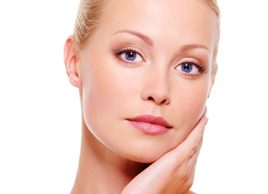What to do about rosacea
For the millions who have it, rosacea can be tough to live with. But there are ways to get relief from the flare-ups and flushes.

Source: Best Health Magazine, January/February 2010
Rosacea is one of the most common skin conditions, and it kind of looks the way it sounds’a red, rosy face. Although it isn’t known exactly how many people in Canada have this disorder, results of an oft-cited Swedish study give us a hint. A random sample of 809 people there found that 14 percent of women and five percent of men had rosacea. A recent Irish study found that 14 percent of subjects examined had rosacea. And it’s estimated that five percent of Americans are affected. Fair-skinned people are more likely to develop it, although it does occur in others as well.
There are four different subtypes of rosacea. In the least trouble-some one, the main symptoms are flushing and redness. In the second subtype, the face is red with acne-like spots and bumps (but no blackheads); in the third, called phymatous rosacea, the skin of the nose is thickened, a condition sometimes called, misleadingly, ‘brandy nose.’ (‘Some people are very troubled by this term,’ says Dr. Yves Poulin, president of the Canadian Dermatology Association and an assistant clinical professor at Laval University in Quebec City. ‘They may be stigmatized as alcoholics’ even if they never drink.) In the fourth subtype’which affects about half of rosacea sufferers’the eyes are itchy and red. One person could have mild symptoms of one subtype and someone else could have a severe case that includes all subtypes.
The facial flushing and pimples from rosacea can come and go through most of adult life, often erupting at stressful times or when you’d like to look your best. ‘As you can see in my wedding photo, I was clear,’ writes one rosacea sufferer on her blog. ‘But I also had on a lot of makeup that day.’ In a 2009 quality-of-life survey of 1,270 people with rosacea conducted by the Rosacea Awareness Program (a national public education program funded by pharmaceutical company Galderma Canada), 30 percent said the condition affects their social life.
About half of people who have rosacea are between the ages of 30 and 60. Women going through menopause are particularly susceptible because of hormonal changes as well as hot flashes. ‘My first rosacea flare-up happened when I turned 40,’ writes a woman on an online rosacea forum. ‘I looked like Mrs. Angry.’ Rosacea fades in old age, and the chances of getting it decrease as you age.
Why does it happen?
The cause of rosacea is not known, but among doctors it is increasingly being seen as an inflammatory reaction by the immune system, says Poulin. Scientific research around the world is exploring what happens inside the skin, and future therapy, he says, will block proteins called cytokines to curb inflammation.
What makes people susceptible to rosacea? It could be a combination of genetics and the environment. Common triggers are spicy food, hot food and beverages, changes in temperature, alcohol, the sun, emotional stress, anger, embarrassment, strenuous exercise, hot baths, saunas, corticosteroids‘which are prescribed for other skin conditions’and medications that dilate blood vessels, including some blood pressure drugs.
There is evidence of other factors at play. Joanne Whitehead, a molecular biologist in Victoria and editor of the Rosacea Research & Development Institute Journal, says studies have found abnormalities in the intestines of rosacea patients. She believes this may be exacerbated by modern, processed foods, but laments the fact that it’s hard to find funding for large studies to prove that. ‘Research and treatment are focused on relief of symptoms such as redness, flushing, spots and visible veins rather than on the holistic approach,’ she says.
What will help?
‘Rosacea can be treated, or at least controlled,’ using antibiotics (for their anti-inflammatory properties) such as tetracycline, doxycycline, minocycline and metronidazole, says Poulin. Depending on the subtype and severity of the condition, your dermatologist may prescribe both oral and topical therapy to bring rosacea under control, followed by topical medication for maintenance. In severe cases of rosacea, isotretinoin (a powerful drug used to treat certain forms of acne, and not without possible serious side effects) may be prescribed. Doctors also recommend sunscreen year-round.
‘What we see is that 40 to 50 percent of patients who received antibiotics for one month or more completely got rid of their rosacea,’ says Poulin. ‘[The other cases] were more persistent. Some people with chronic rosacea need to keep taking medication. But almost everyone can find relief.’
More anti-redness options
For non-prescription daily skin care, there isn’t any ‘one-size-fits-all’ approach, so rosacea sufferers should be willing to experiment. Look for gentle cleansers and moisturizers that don’t contain a lot of perfume. Mild cleansers such as Dove, Spectro Jel and Cetaphil ($3, two 90-g bars; $15, 500 mL; $19, 500 mL, respectively) are generally favoured, says Poulin.
Some cosmetics/skincare companies have anti-redness lines that purport to help calm the skin, and products with yellow or green tints that ‘neutralize’ the redness of rosacea. Clinique Instant Relief Mineral Powder ($40, 24 g) contains a combination of caffeine, magnolia bark, mushroom and grapefruit to soothe the skin, and a hint of yellow in the powder to mask redness. Dermalogica Sheer Tint Redness Relief cream with SPF 15 ($59, 40 mL) combines licorice, oat kernel, pilewort and pro-vitamin B5 as calming forces, and has a green tint to neutralize redness.
B. Kamins Booster Blue Rosacea Masque contains safflower oil to soften skin, anti-inflammatories including bisabolol (a camomile plant extract), plus the company’s signature ‘Bio-Maple compound’ to moisturize ($56, 120 g). Prosacea (not shown) touts itself as a homeopathic topical gel for ‘multi-symptom relief’ ($16, 21 g).




